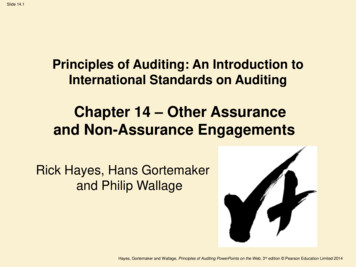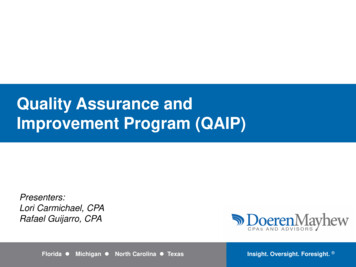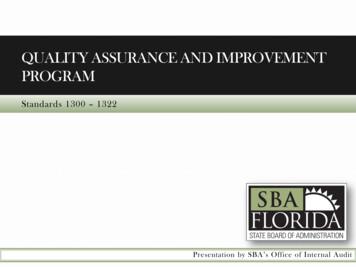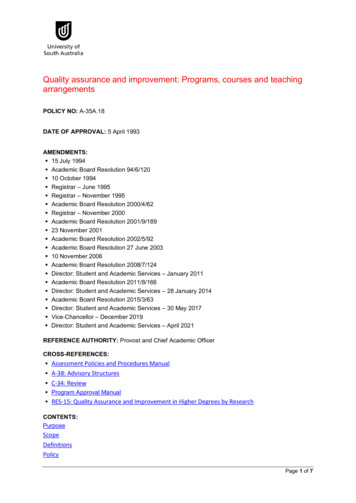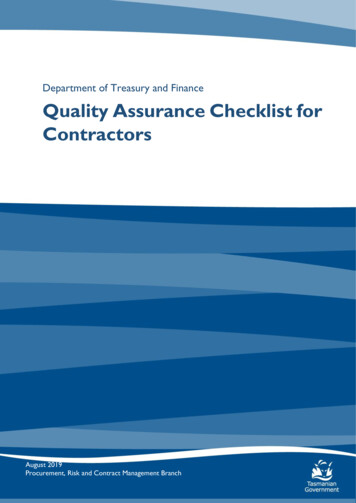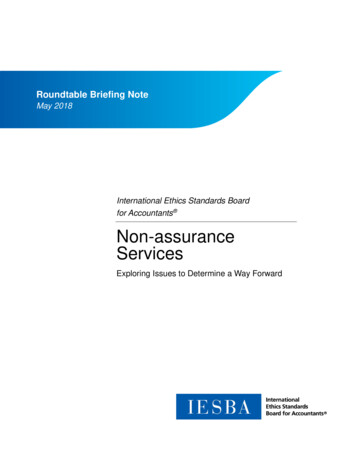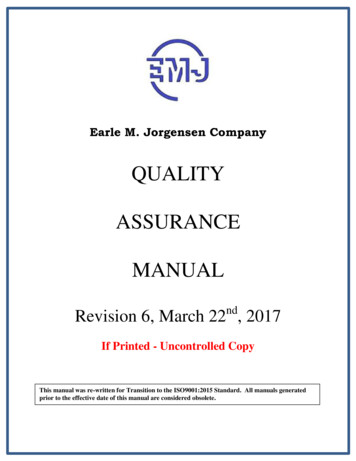
Transcription
Earle M. Jorgensen CompanyQUALITYASSURANCEMANUALndRevision 6, March 22 , 2017If Printed - Uncontrolled CopyThis manual was re-written for Transition to the ISO9001:2015 Standard. All manuals generatedprior to the effective date of this manual are considered obsolete.
EARLE M JORGENSEN QUALITY ASSURANCE MANUALTable of Contents1 SCOPE .42 NORMATIVE REFERENCES .43 TERMS AND DEFINITIONS .43.1 DEFINED ELEMENTS OF THE EMJ QUALITY MANAGEMENT SYSTEM . 44 CONTEXT OF THE ORGANIZATION .54.1 EMJ CONTEXT . 54.2 INTERESTED PARTIES . 54.3 SCOPE OF THE QMS . 64.4 QUALITY MANAGEMENT SYSTEM PROCESSES. 64.4.2 Documented Information to support QMS Processes . 65 LEADERSHIP .65.1 LEADERSHIP AND COMMITMENT . 65.1.1 General. 65.1.2 Customer focus . 75.2 POLICY . 75.2.1 Establishing the quality policy . 75.2.2 Communicating the quality policy . 75.3 ORGANIZATIONAL ROLES, RESPONSIBILITIES AND AUTHORITIES . 76 PLANNING.76.1 ACTIONS TO ADDRESS RISKS AND OPPORTUNITIES . 76.1.1 . 76.1.2 . 86.2 QUALITY OBJECTIVES AND PLANNING TO ACHIEVE THEM. 86.2.1 . 86.2.2 . 86.3 PLANNING OF CHANGES. 87 SUPPORT .97.1 RESOURCES . 97.1.1 General. 97.1.2 People . 97.1.3 Infrastructure . 97.1.4 Environment for the operation of processes . 97.1.5 Monitoring and measuring resources . 97.1.6 Organizational knowledge . 107.2 COMPETENCE . 107.3 AWARENESS . 107.4 COMMUNICATION . 117.5 DOCUMENTED INFORMATION. 117.5.1 General. 117.5.2 Creating and updating . 117.5.3 Control of documented information . 118 OPERATION . 12Page 2 of 27
EARLE M JORGENSEN QUALITY ASSURANCE MANUAL8.1 OPERATIONAL PLANNING AND CONTROL . 128.2 REQUIREMENTS FOR PRODUCTS AND SERVICES. 128.2.1 Customer communication . 128.2.2 Determining the requirements for products and services . 128.2.3 Review of the requirements for products and services . 128.2.4 Changes to requirements for products and services . 138.3 DESIGN AND DEVELOPMENT OF PRODUCTS AND SERVICES . 138.4 CONTROL OF EXTERNALLY PROVIDED PROCESSES, PRODUCTS AND SERVICES . 138.4.1 General. 138.4.2 Type and extent of control . 138.4.3 Information for external providers. 148.5 PRODUCTION AND SERVICES PROVISION . 148.5.1 Control of production and service provision . 148.5.2 Identification and traceability. 148.5.3 Property belonging to customers and external providers . 148.5.4 Preservation . 158.5.5 Post-delivery activities . 158.5.6 Control of changes . 158.6 RELEASE OF PRODUCTS . 158.7 CONTROL OF NONCONFORMING OUTPUTS . 158.7.1 . 158.7.2 . 169 PERFORMANCE EVALUATION . 169.1 MONITORING, MEASUREMENT, ANALYSIS AND EVALUATION . 169.1.1 General . 169.1.2 Customer satisfaction . 169.1.3 Analysis and evaluation . 169.2 INTERNAL AUDIT . 169.2.1 . 169.2.2 . 179.3 MANAGEMENT REVIEW . 179.3.1 General. 179.3.2 Management review inputs . 179.3.3 Management review outputs . 1710 IMPROVEMENT . 1810.1 GENERAL . 1810.2 NONCONFORMITY AND CORRECTIVE ACTION . 1810.2.1 . 1810.2.2 . 1810.3 CONTINUAL IMPROVEMENT . 18ANNEX A– PROCESS MAPS . 21ANNEX B- EMJ ORGANIZATIONAL CHART . 26ANNEX C- EMJ DOCUMENT RETENTION . 27David WeberTechnical DirectorPage 3 of 27Richard PavlikTechnical DirectorShane LuTechnical Director
EARLE M JORGENSEN QUALITY ASSURANCE MANUAL1 ScopeThis quality manual specifies requirements for the quality management system of EMJ:a) To demonstrate its ability to consistently provide products and services that meet customer and applicablestatutory and regulatory requirements.b) To enhance customer satisfaction through the effective application of the system, including processes forimprovement of the system and the assurance of conformity to customer and applicable statutory and regulatoryrequirements.c) EMJ does not conduct any activities associated with Sub-clause 8.3, Design and development.2 Normative referencesThe following documents, in whole or in part, are normatively referenced in this document and are indispensable for itapplication. For dated references, only the edition cited applies. For undated references, the latest edition of thereferenced document (including any amendments) applies.ISO 9001:2015, Quality management systems-Requirements3 Terms and definitionsFor the purposes of this document, the terms and definitions given in ISO 9000:2015 apply.3.1 Defined Elements of the EMJ Quality Management SystemLevel I:Quality Assurance ManualQuality Manual that describes the EMJ’s approach to the requirements of ISO 9001:2015 issued and maintained by theEMJ Technical Directors.Level II:EMJ Corporate Work InstructionsCorporate Work Instructions describing each critical process of EMJ’s operation and the company’s approach to meetingthe requirements of the QAM. Corporate Level WIs are created and maintained by the Technical Directors and eachEMJ/subsidiary branch is allowed creation of supplemental additions tailored to unique processes. Finalized WorkInstructions will be approved at the branch level by Top Management.Level III:EMJ Quality Resources WebsiteThe Company-wide website consolidates the upkeep of documents and quality processes while increasing the visibility ofquality objectives and performance. Implemented by EMJ Technical Directors and maintained, through controlled access,with input from all applicable branch level employees.Page 4 of 27
EARLE M JORGENSEN QUALITY ASSURANCE MANUAL4 Context of the organization4.1 EMJ ContextEarle M Jorgensen Company (EMJ) has determined the following internal and external inputs to be relevant to thepurpose and strategic direction of the company and the QMS:InternalProduct and Service OfferingsEMJ Management / Responsibilities / OrganizationNational Standards and RegulationsCapabilities – Processes and SystemsIT SystemsEmployee Morale and View of the CompanyDelivery and Safety PerformanceExternalDomestic and International LegislationGlobal Issues Impacting Production SectorsGeneral Taxation issuesSeasonal WeatherConsumer Buying PatternsReplacement Technology / SolutionsMaturity of TechnologyThe issues stated above are reviewed during Management Review and evaluated for relevance with respect to the scope ofthe organization. Changes affecting any inputs are identified and considered as risks or opportunities.The review of these issues is based upon an ongoing awareness of current events impacting political, economic, social andtechnological influences on the company.4.2 Interested PartiesThe following interested parties are relevant to the QMS of EMJ:Interested sSuppliersRegulatory Bodies / GovernmentCompetitors*Page 5 of 27Needs and Expectations Quality of productPriceOn-Time delivery of products and servicesTechnical support where neededProfitabilityReturn on investmentContinued growth in the marketIncreased growth, sales and profitabilityEfficiency and effectiveness of processesSuitable work environmentHealth and safetyProper training of job being performedAvailability of tools to complete required jobFeedback on product/service performanceIncreased scope and volume of purchasesLong-term contractual arrangementsInsight and information on future needsCompliance with applicable requirements and industry standardsSubmission of applicable forms and reportsLead times, Pricing, Delivery GoalsMarket knowledgeCapital InvestmentsGaps in product or service offerings
EARLE M JORGENSEN QUALITY ASSURANCE MANUALEMJ monitors and reviews information about these interested parties and their relevant requirements and presents anydevelopments during Management Review.4.3 Scope of the QMSThe Earle M Jorgensen Company distributes and processes ferrous and non-ferrous metals to meet customer requirements.The design functions as defined by the International Standard are not applicable to EMJ and not performing thesefunctions do not impact EMJ’s ability or responsibility to provide product conforming to customer requirements*. TheQuality Management System and Quality Assurance Manual are in accordance with ISO 9001:2015.4.4 Quality Management System ProcessesEMJ has established, implemented, maintained and continually improves a quality management system, based upon thefollowing:a) Inputs and outputs of processes;b) The sequence and interaction of these processes;c) The criteria and methods (including monitoring, measurements and related performance indicators) needed toensure the effective operation and controls of these processes;d) The resources needed for these processes and ensures their availability;e) The responsibilities and authorities for these processes;f) Relevant risks and opportunities as determined in accordance with the requirements of 6.1;The processes relevant to the QMS are shown in Annex A.EMJ also evaluates these processes and implements any changes needed to improve the processes to ensure that theseprocesses achieve their intended results.4.4.2 Documented Information to support QMS ProcessesBased upon organization size, activity, type of products, process complexity and available resources, EMJ maintainsdocumented information and records to support the operation of QMS processes.5 Leadership5.1 Leadership and commitment5.1.1 GeneralThe top management of EMJ demonstrates leadership and commitment to an effective QMS by:a) Taking accountability for the effectiveness of the quality management system;b) Establishing the context and strategic direction of the company and communicating an effective quality policy andrelevant objectives.c) Integrating the QMS into EMJ’s business processes.d) Promoting the use of the process approach and risk based thinking;e) Ensuring that the resources needed for the QMS are available;f) Communicating the importance of effective quality management and of conforming to the quality managementsystem requirements;g) Ensuring that the quality management system achieves its intended results;h) Engaging, directing and supporting persons to contribute to the effectiveness of the QMS;Page 6 of 27
EARLE M JORGENSEN QUALITY ASSURANCE MANUALi)j)Promoting improvement;Supporting other relevant management roles to demonstrate their leadership as it applies to their areas ofresponsibility.5.1.2 Customer focusThe top management of EMJ is committed to enhancing customer satisfaction. The EMJ QMS is reviewed during theManagement Review process to assure that customer requirements are met and that customer satisfaction is enhanced. Inaddition, management reviews:a) customer and applicable statutory and regulatory requirementsb) relevant risks and opportunities.5.2 Policy5.2.1 Establishing the quality policyThe following quality policy has been established, implemented and maintained:The Earle M. Jorgensen Company is a provider of high quality, cost effective products and services.EMJ is committed to maintaining and continuously improving its processes and systems based on the guidelines of ISO9001:2015 in order to satisfy the applicable requirements of the parties interested in the Organization.Our employees understand and implement this policy throughout the company to make sure that,“At EMJ, Quality is the Way We Work.”*5.2.2 Communicating the quality policyThe quality policy is:a) Communicated, understood and appliedb) Available online to all interested parties5.3 Organizational roles, responsibilities and authoritiesRoles, responsibilities and authorities in the EMJ QMS are defined in the relevant process work instructions and theorganizational chart included in Annex B.6 Planning6.1 Actions to address risks and opportunities6.1.1When planning for the quality management system, EMJ considers the issues referred to in 4.1 and the requirementsreferred to in 4.2 and determines the risks and opportunities that need to be addressed in order to:a)b)c)d)Give assurance that the quality management system can achieve its intended result(s);Enhance desirable effects;Prevent, or reduce, undesired effects;Achieve improvement.Page 7 of 27
EARLE M JORGENSEN QUALITY ASSURANCE MANUAL6.1.2EMJ branches evaluate risk based on corporate work instruction 1.8 “Assessment of Risk”. The top management of eachbranch is responsible for evaluating the risks that affect their locations and reviewing these risks at every ManagementReview.6.2 Quality objectives and planning to achieve them6.2.1EMJ establishes quality objectives at relevant functions, levels and processes needed for the quality management system.These objectives are:a) Efficiency1) Tracked by: Expense to Gross Profit Ratiob) Productivity1) Tracked by: Line Items Filled per Employeec) Reliability1) Tracked by: On Time or Free Creditsd) Quality1) Tracked by: Other Sales Credits6.2.2EMJ plans to achieve its quality objectives and determines:a)b)c)d)e)What will be done;What resources will be required;Who will be responsible;When it will be done;How will the results be evaluated.These quality objectives are monitored, communicated and updated as deemed appropriate during Management Review.Documented information regarding Quality Objectives is sent out quarterly for review and plans to achieve them areupdated as necessary.6.3 Planning of changesWhen EMJ determines the need for changes to the quality management system, the changes shall be carried out in aplanned manner.EMJ considers:a)b)c)d)The purpose of the changes and their potential consequences;The integrity of the quality management system;The availability of resources;The allocation or reallocation of responsibilities and authorities.Page 8 of 27
EARLE M JORGENSEN QUALITY ASSURANCE MANUAL7 Support7.1 Resources7.1.1 GeneralEMJ will provide resources and personnel required to establish, implement, and maintain the QMS and continuallyimprove its effectiveness.EMJ will consider the capabilities and constraints of existing internal resources and utilize external providers asnecessary.7.1.2 PeopleEMJ determines and provides the persons necessary for the effective implementation of its quality management systemand for the operation and control of its processes.7.1.3 InfrastructureEMJ determines, provides and maintains the infrastructure necessary for the operation of its processes and to achieveconformity of products and services.Infrastructure includes:a) Buildings, workspaces and associated utilities;b) Process equipment, including hardware and software;c) Supporting services such as transportation, communication or information systems.7.1.4 Environment for the operation of processesEMJ determines, provides and maintains the environment necessary for the operation of its processes and to achieveconformity of products and services. Environment includes:a) Socialb) Psychologicalc) Physical7.1.5 Monitoring and measuring resources7.1.5.1 GeneralEMJ determines and provides the resources needed to ensure valid and reliable results when monitoring or measuring isused to verify the conformity of products and services to requirements.EMJ ensures that the resources provided:a) Are suitable for the specific type of monitoring and measurement activities being undertaken; these resources mayinclude but not be limited to: hardness testers, calipers, and reference gage blocks.b) Are maintained to ensure their continuing fitness for their purpose.Page 9 of 27
EARLE M JORGENSEN QUALITY ASSURANCE MANUAL7.1.5.2 Measurement traceabilityWhen measurement traceability is a requirement, or is considered by EMJ to be an essential part of providing confidencein the validity of measurement results, measuring equipment shall be:a) Calibrated or verified, or both, at specified intervals, or prior to use, against measurement standards traceable toNIST or equivalent international standards; when no such standards exist, the basis used for calibration shall berecorded.b) Identified in order to determine their status.c) Safeguarded from adjustments, damage or deterioration that would invalidate the calibration status andsubsequent measurement results.Records of the results of calibration and verification are maintained. When equipment is found that does not conform torequirements, EMJ assesses the validity of previously measurement results. Appropriate action is taken on the equipmentand any products affected. If computer software or webpage is used in identification, calibration and validation ofmonitoring and measuring equipment it is recorded on the webpage as documented information.7.1.6 Organizational knowledgeEMJ determines the knowledge necessary for the operation of its processes and to achieve conformity of products andservices.Organizational knowledge can be based on:a) Internal sources (e.g. EMJ specifications, ‘tribal knowledge’)b) External sources (e.g. obtaining ASTM/AMS specifications, technical seminars)7.2 CompetenceTraining of each employee consists of:a) Determining the necessary competence of person(s) doing work under its control that affects the performance andeffectiveness of the quality management system;b) Ensuring that they are competent on the basis of appropriate education, training, or experience;c) Where applicable, taking actions to acquire the necessary competence, and evaluating the effectiveness of theactions taken. This can be achieved through training, mentoring, re-assignment, etc.d) Maintaining records of education, training, skills and experience as evidence of competence.Top Management maintains the job specific training documentation of all employees participating in trainingactivities.7.3 AwarenessThe Branch Quality Representative ensures that persons doing work under EMJ’s control are aware of:a) The quality policy;b) Relevant quality objectives;c) Their contribution to the effectiveness of the quality management system, including the benefits of improvedperformance;d) The implications of not conforming to the quality management system requirements.Page 10 of 27
EARLE M JORGENSEN QUALITY ASSURANCE MANUAL7.4 CommunicationThe Branch Quality Representative will determine the internal and external communications relevant to the qualitymanagement system, including;a)b)c)d)e)On what he/she will communicate;When to communicate;With whom to communicate;How to communicate;Who communicates;The Technical Directors will be involved with communications concerning multiple EMJ locations.7.5 Documented information7.5.1 GeneralEMJ’s QAM includes:a) Documented information required by this International St
For the purposes of this document, the terms and definitions given in ISO 9000:2015 apply. 3.1 Defined Elements of the EMJ Quality Management System Level I: Quality Assurance Manual Quality Manual that describes the EMJ’s approach to the requirements of ISO 9001:2015





